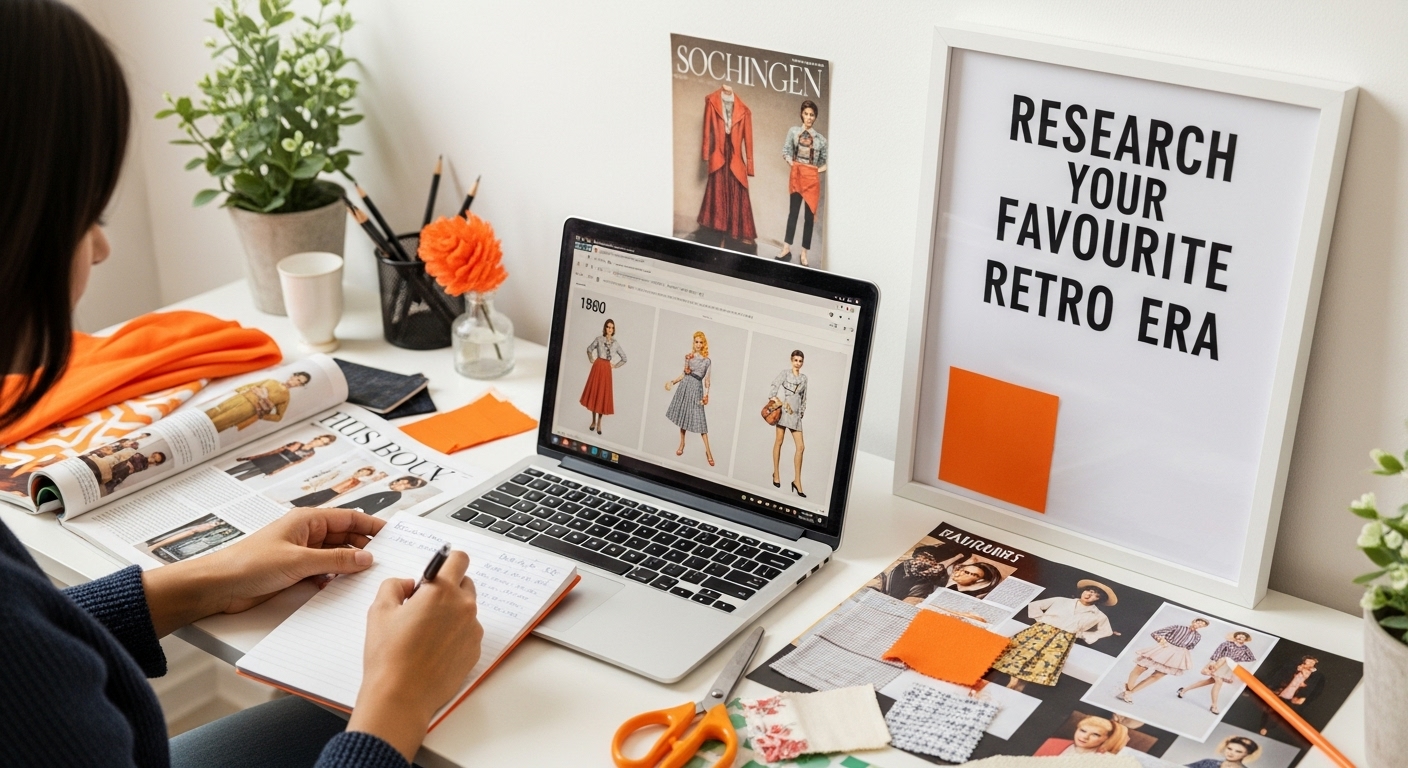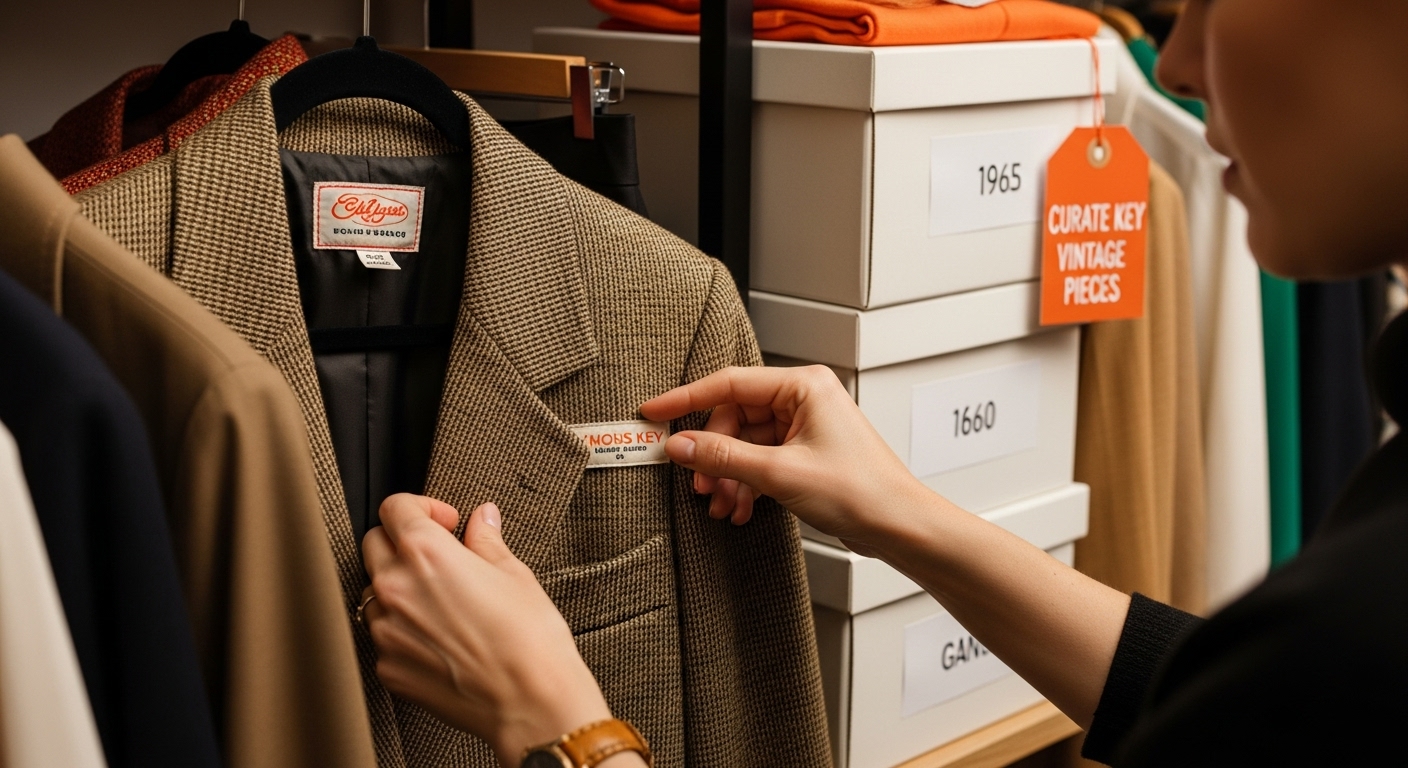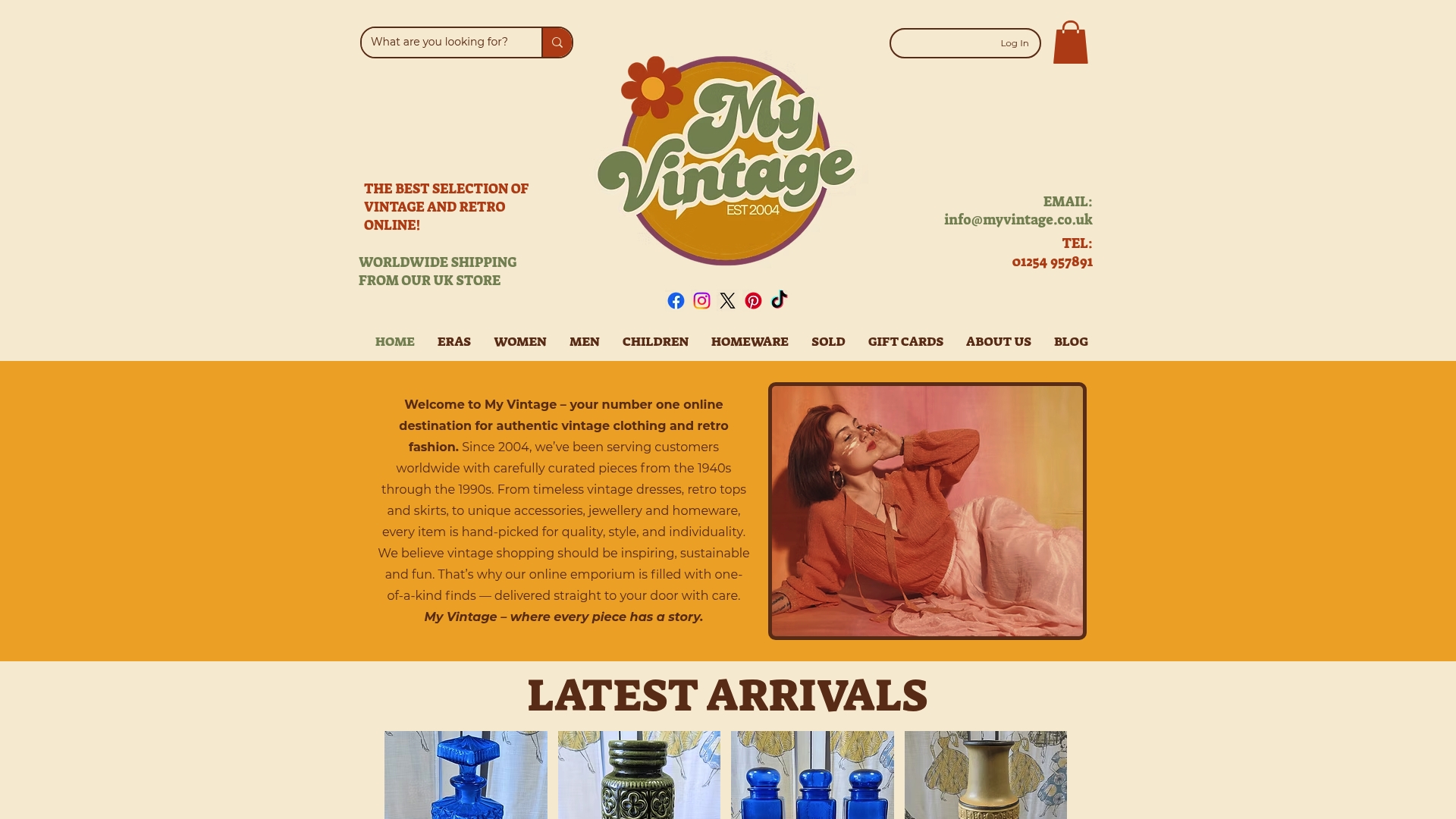How to Dress Retro: A Stylish Journey Through Time
- Emma

- Sep 30
- 10 min read

Retro fashion is back in the spotlight. Style lovers are looking to the past for inspiration and making waves with bold looks from decades gone by. Here is the fun bit: the patterns and cuts from the 1980s and 1960s are so eye-catching that some vintage items have seen demand jump by over 200 percent in the last year alone. Most people think you need a massive wardrobe overhaul to pull off vintage style. Surprise yourself. With a little research and a few clever picks, you can capture the spirit of your favourite era and make it entirely your own.
Table of Contents
Quick Summary
Key Point | Explanation |
1. Research your favourite retro era | Understand different fashion periods to find what suits your style and aesthetic. |
2. Curate key vintage pieces | Choose versatile, historical items that reflect your selected era while fitting your personal style. |
3. Accessorise with authentic vintage items | Use period-specific accessories to enhance your outfit and create a cohesive look. |
4. Experiment with hairstyles and makeup | Learn techniques that reflect the beauty standards of your chosen era for a complete vintage look. |
5. Evaluate your look and make adjustments | Critically reflect on your outfit to refine your vintage style and ensure authenticity. |
Step 1: Research Your Favourite Retro Era
Diving into the world of retro fashion begins with discovering the era that speaks to your personal style and resonates with your aesthetic sensibilities. Each historical period offers a unique visual language, from the structured silhouettes of the 1950s to the bold colours and experimental shapes of the 1980s. Your journey into how to dress retro starts with understanding these distinct fashion moments.
Researching your preferred vintage era requires curiosity and a keen eye for historical detail. Begin by exploring vintage fashion magazines, documentary photography, and classic film archives to understand the authentic clothing styles, fabrics, and cultural context. The 1940s, for instance, reflect wartime pragmatism with utilitarian designs, while the 1960s burst with revolutionary mod aesthetics and bright geometric patterns. Museums, both physical and online, provide exceptional resources for understanding these nuanced fashion periods.
Below is a comparison table highlighting signature clothing styles and characteristics from key vintage fashion decades, to help readers identify and research their favourite retro era.
Decade | Signature Clothing Styles | Key Features & Characteristics |
1940s | Utility dresses, tailored suits | Pragmatic, functional, muted colours, wartime influence |
1950s | Full skirts, fitted blazers, suits | Structured silhouettes, defined waistlines |
1960s | Shift dresses, mod suits | Bright geometric patterns, revolutionary mod aesthetics |
1970s | Flared trousers, maxi dresses | Relaxed lines, bold colours, fluid layering |
1980s | Power suits, statement shoulders | Bold colours, experimental shapes, dramatic proportions |
Visual research platforms like Pinterest and Instagram can be incredibly valuable tools. Follow vintage fashion historians, curators, and collectors who specialise in specific decades. These experts often share intricate details about clothing construction, styling techniques, and cultural significance that go beyond surface-level aesthetics. By immersing yourself in these visual archives, you’ll develop a sophisticated understanding of how clothing reflected societal shifts and individual expression in different eras.
Discover which vintage era matches your personality and start your retro fashion exploration with confidence. Remember, the most successful vintage styling comes from genuine passion and a deep appreciation for the historical context of fashion.
Step 2: Curate Key Vintage Pieces for Your Wardrobe
Curating a vintage wardrobe is an art form that transforms clothing selection from mere shopping to storytelling. After identifying your preferred historical era, the next critical step involves strategically selecting pieces that authentically represent that period while maintaining personal style and wearability. Successful vintage wardrobe curation is about quality, not quantity.
Start by identifying foundational vintage pieces that offer versatility and historical authenticity. A well-tailored 1950s blazer, a crisp 1960s shift dress, or high-waisted 1970s trousers can become cornerstone items that anchor your retro aesthetic. When sourcing these pieces, prioritise condition and fit over absolute perfection. Minor imperfections often add character, but significant structural damage might compromise the garment’s wearability.
Quality vintage hunting requires patience and strategic approach. Vintage markets, specialist consignment stores, and reputable online platforms offer treasure troves for collectors. Look for original manufacturing labels, examine fabric quality, and check for original construction techniques that distinguish genuine vintage from modern reproductions. Authentic vintage pieces often feature superior craftsmanship compared to contemporary mass-produced clothing, with hand-stitched details, unique fabric compositions, and design elements reflecting their historical moment.
Master the art of curating your vintage wardrobe by developing a keen eye for timeless pieces that transcend trends. Remember, building a vintage collection is a gradual process that rewards patience, research, and genuine passion for historical fashion narratives. Each carefully selected piece tells a story, transforming your wardrobe into a personal museum of style and cultural memory.

Step 3: Accessorise with Authentic Vintage Items
Accessories are the secret language of vintage styling, transforming ordinary outfits into extraordinary narratives of historical fashion. Each carefully chosen accessory tells a story, bridging contemporary fashion with the aesthetic nuances of past decades. The art of vintage accessorising goes beyond mere decoration; it’s about creating a cohesive, authentic visual dialogue that speaks to your chosen era’s unique style sensibilities.
Authentic vintage accessories require a discerning eye and understanding of period-specific design elements. Scarves from the 1950s feature distinctly different patterns and fabric weights compared to 1970s iterations. Vintage handbags reveal intricate construction techniques that modern mass-produced accessories cannot replicate. Look for original hardware, hand-stitched details, and materials that reflect the manufacturing techniques of specific decades. Vintage costume jewellery, for instance, can instantly elevate a contemporary outfit, with mid-century brooches, art deco earrings, and carefully curated statement pieces serving as conversation starters.
Navigating vintage accessory acquisition demands patience and strategic research. Antique markets, specialist vintage stores, and carefully curated online platforms offer remarkable opportunities to discover unique pieces. Pay attention to condition, authenticity, and historical accuracy when selecting accessories. Minor wear can add character, but significant damage might compromise the item’s integrity. Consider factors like material durability, potential restoration requirements, and how seamlessly the piece will integrate with your existing wardrobe. Mixing vintage accessories with contemporary clothing creates a dynamic, personal style statement that transcends traditional fashion boundaries.
Learn the art of vintage accessorising and transform your wardrobe into a curated collection that celebrates individual expression and historical fashion narratives. Remember, the most compelling vintage looks emerge from a genuine connection to the story behind each carefully selected piece.
Step 4: Combine Outfits for a Cohesive Retro Look
Creating a cohesive retro look is an intricate dance of balance, authenticity, and personal expression. Successful vintage styling goes beyond simply wearing period pieces; it’s about crafting a narrative that captures the essence of a specific era. The key lies in understanding how different elements harmonise to create a look that feels both historically faithful and individually compelling.
Begin by establishing a primary silhouette that defines your chosen decade. A 1950s look might emphasise structured waistlines and full skirts, while a 1970s ensemble would lean into relaxed, fluid lines and bold colour palettes. Pay attention to proportions and layering techniques specific to your selected era. Vintage styling requires thoughtful consideration of fabric weights, colour combinations, and accessory placement. A meticulously chosen vintage blazer can transform a basic outfit, while carefully selected vintage jewellery can add depth and historical authenticity to your ensemble.
The art of mixing vintage pieces with contemporary clothing demands a nuanced approach. Modern tailoring can be beautifully complemented by vintage accessories, creating a dynamic dialogue between past and present. Consider pairing a vintage silk scarf with a contemporary blazer, or anchoring a modern dress with authentic vintage shoes. The goal is to create a look that feels intentional and sophisticated, rather than costume-like. Texture plays a crucial role in this balancing act, with vintage fabrics often offering unique tactile qualities that modern clothing cannot replicate. Experiment with layering, paying attention to how different textural elements interact and create visual interest.
Discover professional styling techniques for vintage outfits and unlock the potential of your retro wardrobe. Remember, the most compelling vintage looks emerge from a genuine understanding of historical fashion and a confident personal interpretation.
Step 5: Experiment with Hairstyles and Makeup
Authentic retro styling extends far beyond clothing, with hairstyles and makeup serving as the crucial final brushstrokes that transform an outfit from costume to genuine historical expression. Each decade offers a distinct visual language of beauty, where hair and makeup become powerful tools of personal and cultural storytelling. Understanding the nuanced aesthetic principles of your chosen era is essential to creating a truly immersive vintage look.
Hairstyling represents more than mere ornamentation; it’s a complex art form reflecting societal shifts and technological innovations. A 1950s victory roll requires precise pin placement and structural understanding, while 1960s beehive styles demand specific backcombing techniques and structural support. Vintage hair tutorials, professional styling workshops, and archival beauty magazines provide invaluable resources for mastering period-specific techniques. Invest time in learning authentic styling methods, experimenting with period-correct tools like heated rollers, pin curls, and classic setting techniques that create volume and shape unique to specific decades.
Makeup application follows similar historical precision. Colour palettes, application techniques, and product textures varied dramatically across different eras. 1940s makeup emphasised a natural, resilient look with subdued colours reflecting wartime pragmatism, whereas 1980s styles celebrated bold, dramatic expressions with vibrant eyeshadows and pronounced contouring. Vintage makeup is about understanding the cultural context that shaped beauty standards, not just replicating surface aesthetics. Vintage makeup tutorials, historical beauty magazines, and specialist vintage beauty workshops can provide deep insights into authentic application techniques. Consider practising with period-correct colour palettes, studying vintage makeup advertisements, and understanding how social movements and cultural changes influenced beauty standards.
Explore the evolution of makeup through different decades and unlock the transformative power of historical beauty techniques. Remember, the most compelling vintage looks emerge from a genuine appreciation of historical aesthetic nuances and confident personal interpretation.
Step 6: Evaluate Your Look and Make Adjustments
The journey of mastering retro style is an ongoing process of refinement, where critical self-evaluation becomes the cornerstone of developing an authentic vintage aesthetic. Successful vintage styling demands a delicate balance between historical accuracy and personal expression, requiring consistent reflection and strategic adjustments. This final step transforms your vintage exploration from a mere costume exercise into a sophisticated personal fashion narrative.
Begin by documenting your vintage ensemble through multiple perspectives. Photographing your outfit from different angles provides objective insight into how historical elements harmonise and where potential improvements can be made. Pay close attention to proportions, colour interactions, and the overall visual narrative your outfit communicates. Critically examine how vintage pieces interact with contemporary elements, ensuring your look feels intentional rather than contrived. Consider the functionality of your outfit beyond aesthetic appeal - vintage fashion should not only look remarkable but also feel comfortable and practical for your lifestyle.
Here is a quick reference checklist to help you evaluate, refine, and perfect your retro look by following the article’s evaluation and adjustment steps.
Evaluation Check | Details |
Photograph outfit | Capture from multiple angles to check silhouette and details |
Examine proportions | Assess how vintage and modern pieces interact |
Assess colour harmony | Review if period-appropriate colours work coherently together |
Test comfort and fit | Ensure outfit is not only authentic but also practical to wear |
Seek external feedback | Ask vintage communities and experts for critique and suggestions |
Make small adjustments | Remove or swap accessories, alter hems, rebalance combinations |
Constructive self-critique involves understanding the subtle nuances that elevate a vintage look from costume to curated style. Seek feedback from vintage fashion communities, attend retro styling workshops, and engage with fellow enthusiasts who can offer nuanced perspectives. Professional vintage stylists and historical fashion experts can provide invaluable insights into refining your approach. Look for opportunities to deconstruct your outfit, understanding how individual pieces contribute to the overall aesthetic. Be prepared to make incremental adjustments - removing an accessory, altering a hemline, or rebalancing colour combinations can dramatically transform your vintage interpretation.

Explore professional styling techniques for vintage outfits and continue your journey of sartorial self-discovery. Remember, mastering retro style is less about perfect replication and more about developing a personal dialogue with fashion history.
Ready to Transform Your Look with Genuine Vintage?
You have explored how to curate authentic retro outfits, source timeless accessories, and refine your style from decade to decade. Perhaps you are facing the challenge of finding true vintage pieces that truly capture the quality and historical value described in “How to Dress Retro: A Stylish Journey Through Time”. It can be difficult to spot genuine articles and start building a wardrobe that is both unique and sustainable. At My Vintage, we address these common struggles with our curated online collection, where every item is hand-selected for authenticity and character.

Why settle for mass-produced reproductions when you can access the real thing? Unlock our exclusive range of handpicked vintage clothing, accessories and retro homeware at My Vintage and turn your research into reality. Embrace individuality, support sustainable fashion, and start shopping for rare finds that bring your favourite fashion era to life. Visit My Vintage now to start building a wardrobe that tells your personal story through pieces with true historical heart.
Frequently Asked Questions
What should I consider when researching my favourite retro era?
When researching your preferred vintage era, consider exploring vintage fashion magazines, classic film archives, and documentary photography. This will help you understand the authentic clothing styles and cultural context of different periods.
How can I curate a vintage wardrobe effectively?
To curate a vintage wardrobe, focus on quality over quantity. Identify key vintage pieces such as blazers, dresses, or trousers that anchor your retro aesthetic while prioritising condition and fit. Look for historical authenticity and craftsmanship in your selections.
What tips can I follow for accessorising with vintage items?
When accessorising with vintage items, ensure that your accessories reflect the era’s unique design elements. Pay attention to quality, authenticity, and period-specific details. Mixing vintage accessories with contemporary clothing can create a dynamic, personal style statement.
How can I evaluate my retro look and make improvements?
To evaluate your retro look, photograph your ensemble from various angles to gain objective insight into its overall aesthetic. Seek feedback from vintage fashion communities to understand how to refine your style and make incremental adjustments for the best results.
Recommended









Comments